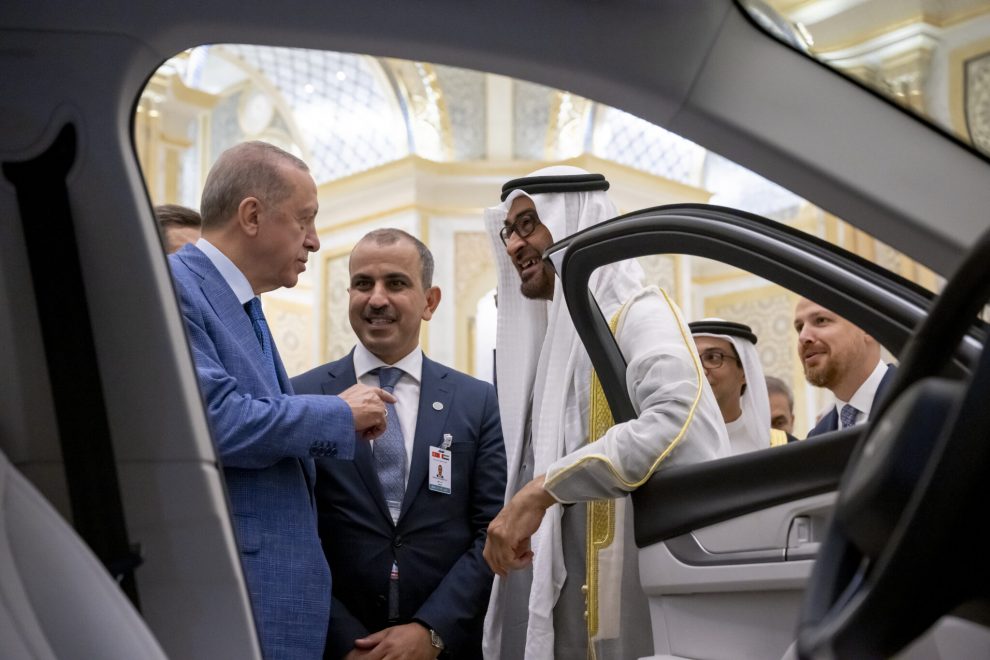- The act of presenting an electric car to the leaders of major fossil fuel-producing countries by Erdoğan highlights a shift in regional perspectives on future energy sources
- As these countries — including Saudi Arabia, UAE and Qatar — progress to the next phase of their economic diversification, Turkiye can emerge as a dependable partner
ISTANBUL — When Turkish President Recep Tayyip Erdoğan visited the Gulf region in July, he presented the country’s first domestically-produced electric car TOGG to Crown Prince Mohammed Bin Salman in Saudi Arabia, President Sheikh Mohammed Bin Zayed Al Nahyan in the United Arab Emirates, and Qatar’s Emir Sheikh Tamim Bin Hamad Al Thani.
The gesture of presenting an electric car to the leaders of countries that are power houses of fossil fuels would not have been seen as serious about two decades ago, but judging by regional media attention, Erdoğan’s gift has not only been appreciated but it also displays a shift in regional thinking about future energy sources.
Of course, the Gulf states will remain major players in the hydrocarbon sector in the foreseeable future, but they are also part of worldwide efforts to cut down carbon emissions and are making significant investments in renewable energy. Electric vehicles will increasingly become more visible in the green energy drive.
Investments in renewable energy also fit well with Arab regional economic diversification efforts. The International Renewable Energy Agency (IRENA), of which Turkiye is a founding member, is headquartered in Abu Dhabi. It clearly shows the region’s significance in the global renewable push.
Gulf countries have been preparing themselves for the post-oil scenario for a long time as they are well aware that oil and gas will eventually run out or will not generate sufficient revenues.
Turkiye as a leading economy in the wider region can play a strategic role in their diversification push if political and business leaders put their mind to this issue on which the region’s future prosperity depends.
Before we discuss the potential of cooperation between Turkiye and the Gulf Cooperation Council (GCC) bloc further, let us first look at how the GCC has done so far on the diversification front.
Gulf Arabs are fully aware that renewable energy alternatives to fossil fuels are being developed around the world, especially in key consumer nations of East Asia and the European Union. Not in the distant future, countries will prefer wind or solar power instead of natural gas to produce electricity, which is also replacing oil for powering cars. Hence, in order not to be caught unawares, the GCC is smartly investing in new economic resources to diversify their economies.
It can be said that they are about to achieve their diversification goal and the coming years will be better than current days in terms of non-oil revenues. While the share of hydrocarbon revenue in all the six Gulf states’ gross domestic economy (GDP) is declining every year, the UAE has already reduced its dependence on oil and gas income to less than 40 per cent. Certainly, other countries will follow the UAE and grow their non-hydrocarbon resources by boosting sectors such as aviation, manufacturing, services and tourism.
Qatar’s economic diversification efforts have been successful as well, with the aviation, finance and services sectors emerging as notable contributors to the economy.
While other Gulf states are behind Qatar and the UAE, they are also pursuing well-thought economic diversification models suited to their unique social and economic conditions.
Saudi Arabia has already joined the trend, thanks to the economic ambition of its Crown Prince Muhammed Bin Salman. Certainly, projects like Neom, investments in sports and multinational corporations will soon pay off. Thus, besides Qatar and the UAE, Saudi Arabia may reduce its huge dependency on oil in the near future.
Another important aspect of diversification comes in the form of gaining knowhow, economic management experience and benefits of engaging with the wider world in a range of sectors from agriculture to aerospace. Gulf officials and people now have skills in banking, tourism, aviation, manufacturing, trading, marketing, branding and management as good as they have in the hydrocarbon business.
This experience can easily be converted into revenue even when capital is scarce. In other words, the biggest gain for these countries lies in the higher level of qualifications of their people.
We can safely say that the UAE, Qatar and Saudi Arabia have already passed the most difficult phase in their diversification drive.
As they enter the second phase of their economic diversification, focusing on renewable energy technologies, cutting-edge manufacturing, building food security, and harnessing defense and military knowhow, Turkiye can be a dependable partner for them.
There will be opportunities for technology transfer as well as joint development and collaboration, using each other’s core strengths.
In the defense sector, Turkish expertise and Gulf capital can produce a brilliant combination, considering Turkiye’s advances in drone technology and conventional weapons systems.
The nuclear power sector also holds potential for mutual collaboration as both Turkiye and the UAE are building their first reactors and other countries may follow suit.
Russia’s Rosatom will start work on the commissioning of unit 1 of the Akkuyu NPP in Turkiye in the third quarter of this year.
Unit 1 and 2 of the Barakah plant in Abu Dhabi, constructed by Korea Electric Power Corp (KEPCO), are already producing commercial power. The total combined capacity of all four reactors at 5,600 megawatts (MW) will be equivalent to around 25 per cent of the UAE’s peak demand.
This will be a great leap forward in the UAE’s goals to cut greenhouse gas emissions. As per published reports, citing Emirates Nuclear Energy Corporation (ENEC), it will cut about 22.4 million tons of carbon emissions annually, which is equivalent to the emissions of 4.8 million cars.
Similarly, Saudi Arabia’s role in the region’s energy transition is going to be crucial. The country aims to cut annual greenhouse gas emissions by 278 million tons of CO2 by 2030. According to a report, its renewable energy generation capacity grew to 443MW in 2021 from 24.3MW in 2016. It plans to develop one of the world’s biggest green hydrogen facilities.
In Turkiye, government efforts have focused on expanding renewable energy sources. Turkiye ranked 5th in Europe and 12th globally in terms of installed capacity in renewable energy last year. The share of renewables in its installed power reached 54 per cent in 2022.
Turkish renewable goals are driven both by its desire to reduce dependence on oil and gas imports as well as the ideal of a low-carbon future. Energy diversification is a major part of Turkiye’s national economic strategy. Its significant success in the past decade in the hydropower, solar and wind segments will receive further boost from nuclear power.
With so much regional focus on energy diversification, closely linked to economic diversification, Turkiye can join hands with Saudi Arabia, the UAE and other countries in the region in a collaborative approach that will produce cost-effective and viable energy solutions for a brighter regional future.
Source: Trendsmena.com






